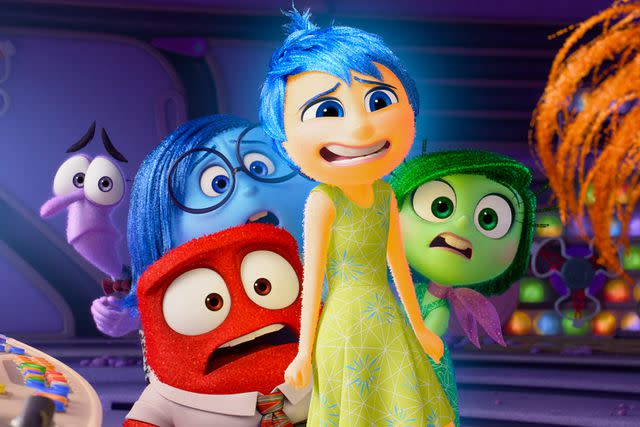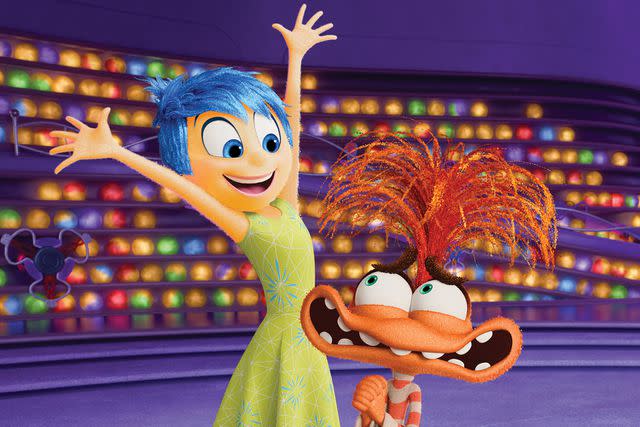“Inside Out 2 ”adds new emotions, but it’s the same old story
Despite a cast of new characters, the Pixar sequel is a bit of a dim bulb compared to the original.
Nine summers ago, Inside Out burst onto screens with bright hues and a wildly creative visualization of human interiority. (Well, so long as you never saw the early '90s sitcom Herman's Head.) Though as madcap and set piece-driven as any other animated Pixar movie, its bittersweet conclusion maturely showed how personal growth emerges from the harmony of conflicting emotions. (To keep with the theme of old sitcoms, "You take the good, you take the bad, you take them both, and there you have the facts of life.”) Inside Out 2, however, retreads much of the same arc as the original but with far less imagination, delivering the same message with a few added characters.
Which is not to say that Inside Out 2 is wholly without merit. The mind of young Riley Andersen is still fertile ground for chuckles. The little girl figuring out her way in the world is now 13, and that means the five emotions that drive her personality — Joy (Amy Poehler), Sadness (Phyllis Smith), Anger (Lewis Black), Fear (Tony Hale, taking over from Bill Hader), and Disgust (Liza Lapira, taking over from Mindy Kaling) — are awakened one night to a buzzing red puberty alarm. After workers messily expand the control center of Riley's consciousness, three new colorful anthropomorphized emotions appear — Envy (Ayo Edebiri), Ennui (Adèle Exarchopoulos, who doesn't do much but steals the few scenes she has), Embarrassment (Paul Walter Hauser), and the new boss in town, Anxiety (Maya Hawke). Don't worry, there's no visit from a character named Purience or anything like that unless you count a quick glimpse at the faces on the amusingly named Mount Crushmore.

PIXAR
The emotions of 'Inside Out 2' : (L-R) Fear (voice of Tony Hale), Sadness (voice of Phyllis Smith), Anger (voice of Lewis Black), Joy (voice of Amy Poehler), and Disgust (voice of Liza Lapira)Related: Welcome to the Belief System, a core part of Riley's mind in Inside Out 2
At first, you might think anxiety, as a concept, is already covered between fear and sadness, but that's an old way of thinking. Inside Out 2's Anxiety is not someone frozen in panic. She's a take-charge go-getter who spots problems coming a mile away and swiftly forms solutions. As Riley heads off to three crucial days of hockey camp (where, if she does well, she'll get recruited for the team of her dreams), she learns that her two best pals are going to a different school next year. She’s got to find a new crew and fit in with them, and fast. The older emotions — the ones that have aided Riley in creating her Sense of Self (a glowy thing that looks like a cross between the Flux Capacitor and the Crystalline Entity from Star Trek: The Next Generation) — are hurdles to Anxiety and the new crew, and are soon “bottled up,” then carted away to an emotional oubliette.
The eventual detente between the old and new characters comes after a series of side quests for the OG crew that come off as somewhat rushed and not that innovative. When our heroes ride a literal Stream of Consciousness, I have to be honest — I was reminded of seeing the same gag in one of the worst and most cravenly cash-grabbing kiddie flicks of recent years, The Emoji Movie. Other obstacles feel a little cheap, too, like dodging lightbulb-shaped ideas in a “brainstorm.” A better pun comes when Ennui psychologically alters Riley's mind, creating a “sar-chasm” (visualized as canyons) in her personality — high five to screenwriters Meg LeFauve and Dave Holstein for that one.
Related: Meet Riley's new turtleneck-sporting emotion — voiced by Maya Hawke! — in the Inside Out 2 trailer
The parallel action to Joy and friends making their trek to a distant realm of suppressed memories (it looks a little like the original Tron) is a will-she-make-the-team/do-the-older-kids-like-her struggle at hockey camp that lacks a real sense of urgency. The meat of this is surprisingly thin when you look past all the brightly lit multicolored memory orbs flying over the screen.
Want more movie news? Sign up for Entertainment Weekly's free newsletter to get the latest trailers, celebrity interviews, film reviews, and more.

PIXAR
(L-R) Joy (voiced by Amy Poehler) and Anxiety (voiced by Maya Hawke) in 'Inside Out 2'The best thing in Inside Out 2, both in concept and execution, is Anxiety herself. The rote version would be a Woody Allen-ish nebbish with flop sweat and existential quips, but the stringy orange creature and Maya Hawke’s high-energy vocal performance is the rare example of originality in this picture. Anxiety’s “projections” actually do help Riley negotiate the unfamiliar social setting of hockey camp, at least at first. Could it be that her frenzied, hyperactive method of catastrophizing and slipping into false personas for the sake of winning affection is actually… good?
Related: Drew Barrymore gets emotional while discussing Inside Out 2: 'I have chills everywhere'
No! Of course not! That would be ludicrous. Anxiety eventually spirals out of control into paralysis, but, importantly, her actions never stem from maliciousness. She just wants Riley to be happy, which is what all of the emotions want. As in the first film, it's negotiating a balance inside her head that is going to allow that to happen. That said, I await with glee the day I can read some trollish essays arguing on behalf of Anxiety's schemes in the mold of classics like "The Destruction of Alderaan Was Completely Justified" and "Night of the Living Dead: Why Cooper Was Right."
Despite the xeroxed nature of the movie's central themes, it's still some weighty stuff for a kid's film, which has its positives and negatives. Inside Out 2 can surely be used by parents as a teaching tool if a kid ever spirals into a freak-out before entering a new school or having a big audition. But even with the antic animation, a funny dig at Blue's Clues, and a color palette resembling an exploded box of Trix cereal, the movie suffers from a bit of a do-your-homework vibe. Going to a Pixar movie these days means shouting, "Get in the car, kids, we're gonna go learn some life lessons!" No one is growing after going to see Minions. I don't know what it says about which emotion is behind the wheel inside of me, but sometimes just laughing and being noisy is a preferable option for family entertainment. Grade: B-
Read the original article on Entertainment Weekly.


